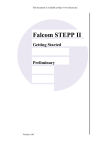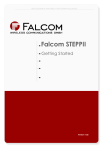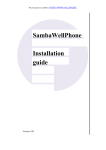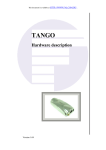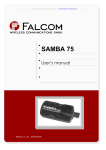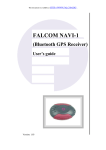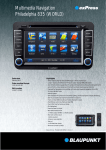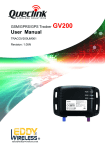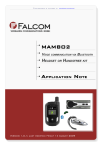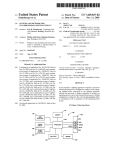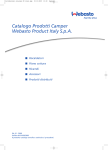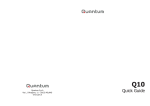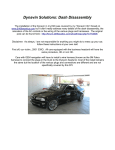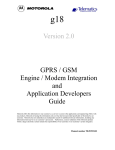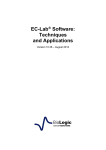Download STEPP Hardware description
Transcript
This document is available at HTTP://WWW.FALCOM.DE/ . STEPP Hardware description Version 1.10 STEPP VERSION 1.10 Index of contents 0 INTRODUCTION ..............................................................5 0.1 0.2 0.3 GENERAL ........................................................................................................................................ 5 USED ABBREVIATIONS .................................................................................................................... 6 RELATED DOCUMENTS.................................................................................................................... 7 1 SECURITY .........................................................................8 1.1 1.2 1.3 1.4 1.5 1.6 1.7 1.8 1.9 1.10 1.11 1.12 1.13 GENERAL INFORMATION ................................................................................................................. 8 EXPOSURE TO RF ENERGY .............................................................................................................. 8 EFFICIENT MODEM OPERATION ....................................................................................................... 8 ANTENNA CARE AND REPLACEMENT .............................................................................................. 9 DRIVING ......................................................................................................................................... 9 ELECTRONIC DEVICES..................................................................................................................... 9 VEHICLE ELECTRONIC EQUIPMENT ................................................................................................. 9 MEDICAL ELECTRONIC EQUIPMENT ................................................................................................ 9 AIRCRAFT ....................................................................................................................................... 9 CHILDREN .................................................................................................................................... 10 BLASTING AREAS .......................................................................................................................... 10 POTENTIALLY EXPLOSIVE ATMOSPHERES ..................................................................................... 10 NON-IONISING RADIATION ............................................................................................................ 10 2 SAFETY STANDARDS ...................................................11 3 TECHNICAL DATA........................................................12 4 FUNCTIONAL DESCRIPTION.....................................13 4.1.1.1 Determining the External Equipment Type .................................................................................................. 14 5 GSM CORE ......................................................................16 5.1 5.2 5.2.1 GENERAL ...................................................................................................................................... 16 GSM DATA SERVICES ................................................................................................................... 16 RF characteristics......................................................................................................................... 16 6 GPS CORE........................................................................18 6.1 6.2 6.2.1 GENERAL ...................................................................................................................................... 18 TECHNICAL DATA ......................................................................................................................... 18 NMEA data message ................................................................................................................... 18 7 HARDWARE INTERFACES .........................................19 7.1 7.1.1 7.1.2 INTERFACE A (16PIN MOLEX 43045-1609) .................................................................................. 20 Description of the 16- pin connector ........................................................................................... 20 Special pin description................................................................................................................. 21 7.1.2.1 7.1.2.2 7.1.2.3 7.1.2.4 7.1.2.5 Analog inputs (pin 2, 4)................................................................................................................................ 21 Inputs (pin 6, 8, 10, 12) ................................................................................................................................ 22 Outputs (pin 5, 7, 9, 11) ............................................................................................................................... 23 BATT On/Off (pin 14)................................................................................................................................... 23 Ignition (pin 13) ........................................................................................................................................... 24 7.2 7.3 7.4 7.4.1 7.4.2 INTERFACE B (SIM-CARD INTERFACE MOLEX-91228-0002) ....................................................... 25 INTERFACES C AND D................................................................................................................... 26 INTERFACE E (AMP 5-558556-1 CONNECTOR) ........................................................................... 26 The 15- pin connector description ............................................................................................... 27 Special pin description................................................................................................................. 27 7.4.2.1 7.4.2.2 7.4.2.3 7.4.2.4 VC 5 ............................................................................................................................................................. 27 Boot select .................................................................................................................................................... 28 RxA, TxA....................................................................................................................................................... 28 Speaker outputs characteristics.................................................................................................................... 28 This confidential document is a property of FALCOM GmbH and may not be copied or circulated without previous permission. Page 1 STEPP VERSION 1.10 7.5 INTERFACE F (LED’S DESCRIPTION) ............................................................................................ 28 8 HOUSING .........................................................................29 9 STEPP-MOUNTING BRACKET...................................30 10 APPENDIX .......................................................................31 10.1 10.1.1 10.1.2 SCHEMATICS................................................................................................................................. 31 Installation guidance for 16pin Molex connector ........................................................................ 31 Installation guidance for 15-pin AMP connector......................................................................... 32 This confidential document is a property of FALCOM GmbH and may not be copied or circulated without previous permission. Page 2 STEPP VERSION 1.10 Version history: Version number 1.00 Author Fadil Beqiri 1.01 Fadil Beqiri 1.02 J.Skeide 1.03 Fadil Beqiri 1.04 Fadil Beqiri 1.05 Fadil Beqiri 1.06 Fadil Beqiri 1.07 Fadil Beqiri 1.08 Fadil Beqiri 1.09 Fadil Beqiri 1.10 Fadil Beqiri Changes Initial version Schematic example (figure 18) optimize Pin 14(Molex 16 pin) described Table 9: output description modified Table 9: output description modified Schematics example (figure 8, 9) optimize Pin 14 in schematic example (figure 18) added The names of Pin (5 and 7) on the Table 9 are changed. Update of Pin 14 (BATT ON/OFF) Current consumption in Standby updated. The names of Pin (5 and 7) in the Table 9 are changed. New feature of the GPS LED (yellow one) on the chapter 4 Functional description added. Current consumption in Standby mode removed. Output 1 and 2 on the 16-pin Molex connector exchanged to pin 7 and 5 respectively (table 9 updated). Figure 18 updated, too. The BATT On/Off pin on the 16pin connector updated. The schematic example (figure 18) improved (a 2A-Fuse added). This confidential document is a property of FALCOM GmbH and may not be copied or circulated without previous permission. Page 3 STEPP VERSION 1.10 Cautions Information furnished herein by FALCOM are accurate and reliable. However, no responsibility is assumed for its use. Please read carefully the safety precautions. If you have any technical questions regarding this document or the product described in it, please contact your vender. General information about FALCOM and its range of products is available at the following internet address: http://www.falcom.de/ Trademarks Some mentioned products are registered trademarks of their respective companies. Copyright The STEPP user’s guide is copyrighted by FALCOM GmbH with all rights reserved. No part of this user’s guide may be produced in any form without the prior written permission of FALCOM GmbH. FALCOM GmbH. No patent liability is assumed with respect to the use of the information contained herein. This confidential document is a property of FALCOM GmbH and may not be copied or circulated without previous permission. Page 4 STEPP VERSION 1.10 0 Introduction 0.1 General This description is focused on the GSM/GPS terminal STEPP from Falcom GmbH. It contains short information about purpose and use of the STEPP concept. The STEPP is a combined GSM/GPS device. Figure 1 shows the front and back side of the STEPP. Please read this User Manual very carefully to avoid mistakes and to make sure an optimal use of the device. a) back side b) front side figure 1: front and back side of STEPP The STEPP architecture integrates (see figure 2): high-performance Dual-Band GSM core 12 parallel channel low-power GPS core ARM7TDMI Processor that controls all functions of the system Power Control circuitry with 1100 mAh Li-Ion, backup battery Audio amplifier Interface circuitry The STEPP has the following external interfaces: 16 pin Molex connector (Type: Molex 43045-1609) for power supply and I/O’s 15pin AMP connector (Type: AMP5-558556-1) for audio interfaces and software update SIM Card reader (Type: Molex-91228-0002 small SIM Card ) GSM antenna interfaces (Type: Connector 50 Ω Fakra/Radial SMBmale) GSM antenna interfaces (Type : Connector 50 Ω Fakra/Radial SMBmale) This confidential document is a property of FALCOM GmbH and may not be copied or circulated without previous permission. Page 5 STEPP VERSION 1.10 r figure 2: Architecture of the STEPP 0.2 Used abbreviations Abbreviation Description DOP Dilution of Precision GPS Global Positioning System GSM Global Standard for Mobile Communications GGA GPS Fixed Data HDOP Horizontal DOP HW Hardware IMEI International Mobile Equipment Identity I/O Input/Output NMEA National Marine Electronics Association PRN Pseudorandom Noise Number – The Identity of GPS satellites RF Radio Frequency RTC Real Time Clock RXQUAL Received Signal Quality SIM Subscriber Identification Module SMS Short Message Service This confidential document is a property of FALCOM GmbH and may not be copied or circulated without previous permission. Page 6 STEPP VERSION 1.10 Abbreviation Description SRAM Static Random Access Memory TA Terminal Adapter TE Terminal Equipment TP Transmit Protocol TTFF Time to First Fix SA Selective Availability WAAS Wide Area Augmentation System MSK Minimum Shift Keying table 1: Used abbreviations 0.3 Related documents 1. ETSI GSM 07.05:“Use of Data Terminal Equipment–Data Circuit terminating Equipment interface for Short Message Service and Cell Broadcast Service” 2. ETSI GSM 07.07“AT command set for GSM Mobile Equipment” 3. ITU-T V.25ter“Serial asynchronous automatic dialling and control” 4. SiRF binary and NMEA protocol specification; www.falcom.de/Service/Manuals/SiRF This confidential document is a property of FALCOM GmbH and may not be copied or circulated without previous permission. Page 7 STEPP VERSION 1.10 1 Security IMPORTANT FOR THE EFFICIENT AND SAFE OPERATION OF YOUR GSM-MODEM, READ THIS INFORMATION BEFORE USE! Your cellular engine STEPP is one of the most exciting and innovative electronic products ever developed. With it you can stay in contact with your office, your home, emergency services and others, wherever service is provided. This chapter contains important information for the safe and reliable use of the STEPP. Please read this chapter carefully before starting to use the cellular engine STEPP. 1.1 General information Your STEPP device utilises the GSM/GPS standard for cellular technology. GSM is a newer radio frequency („RF“) technology than the current FM technology that has been used for radio communications for decades. The GSM standard has been established for use in the European community and elsewhere. Your modem is actually a low power radio transmitter and receiver. It sends out and receives radio frequency energy. When you use Your modem, the cellular system handling your calls controls both the radio frequency and the power level of Your cellular modem. 1.2 Exposure to RF energy There has been some public concern about possible health effects of using GSM modem. Although research on health effects from RF energy has focused for many years on the current RF technology, scientists have begun research regarding newer radio technologies, such as GSM. After existing research had been reviewed, and after compliance to all applicable safety standards had been tested, it has been concluded that the product is fit for use. If you are concerned about exposure to RF energy there are things you can do to minimize exposure. Obviously, limiting the duration of your calls will reduce your exposure to RF energy. In addition, you can reduce RF exposure by operating Your cellular modem efficiently by following the guidelines below. 1.3 Efficient modem operation In order to operate Your modem at the lowest power level, consistent with satisfactory call quality please take note of the following hints. If Your modem has an extendible antenna, extend it fully. Some models allow you to place a call with the antenna retracted. However Your modem operates more efficiently with the antenna fully extended. Do not hold the antenna when the modem is „IN USE“. Holding the antenna affects call quality and may cause the modem to operate at a higher power level than needed. This confidential document is a property of FALCOM GmbH and may not be copied or circulated without previous permission. Page 8 STEPP VERSION 1.10 1.4 Antenna care and replacement Do not use the modem with a damaged antenna. If a damaged antenna comes into contact with the skin, a minor burn may result. Replace a damaged antenna immediately. Consult your manual to see if you may change the antenna yourself. If so, use only a manufacturer-approved antenna. Otherwise, have your antenna repaired by a qualified technician. Use only the supplied or approved antenna. Unauthorized antennas, modifications or attachments could damage the modem and may contravene local RF emission regulations or invalidate type approval. 1.5 Driving Check the laws and regulations on the use of cellular devices in the area where you drive. Always obey them. Also, when using Your modem while driving, please pay full attention to driving, pull off the road and park before making or answering a call if driving conditions so require. When applications are prepared for mobile use they should fulfil road-safety instructions of the current law! 1.6 Electronic devices Most electronic equipment, for example in hospitals and motor vehicles is shielded from RF energy. However RF energy may affect some malfunctioning or improperly shielded electronic equipment. 1.7 Vehicle electronic equipment Check Your vehicle manufacturer’s representative to determine if any on board electronic equipment is adequately shielded from RF energy. 1.8 Medical electronic equipment Consult the manufacturer of any personal medical devices (such as pacemakers, hearing aids, etc.) to determine if they are adequately shielded from external RF energy. Turn Your STEPP device OFF in health care facilities when any regulations posted in the area instruct you to do so. Hospitals or health care facilities may be using RF monitoring equipment. 1.9 Aircraft Turn Your STEPP OFF before boarding any aircraft. Use it on the ground only with crew permission. Do not use it in the air. To prevent possible interference with aircraft systems, Federal Aviation Administration (FAA) regulations require you to have permission from a crew member to use Your modem while the plane is on the ground. To prevent interference with cellular systems, local RF regulations prohibit using Your modem whilst airborne. This confidential document is a property of FALCOM GmbH and may not be copied or circulated without previous permission. Page 9 STEPP VERSION 1.10 1.10 Children Do not allow children to play with Your STEPP device. It is not a toy. Children could hurt themselves or others (by poking themselves or others in the eye with the antenna, for example). Children could damage the modem or make calls that increase Your modem bills. 1.11 Blasting areas To avoid interfering with blasting operations, turn Your unit OFF when in a “blasting area” or in areas posted: „turn off two-way radio“. Construction crew often use remote control RF devices to set off explosives. 1.12 Potentially explosive atmospheres Turn Your STEPP device OFF when in any area with a potentially explosive atmosphere. It is rare, but Your modem or its accessories could generate sparks. Sparks in such areas could cause an explosion or fire resulting in bodily injury or even death. Areas with a potentially explosive atmosphere are often, but not always, clearly marked. They include fuelling areas such as petrol stations; below decks on boats; fuel or chemical transfer or storage facilities; and areas where the air contains chemicals or particles, such as grain, dust or metal powders. Do not transport or store flammable gas, liquid or explosives, in the compartment of Your vehicle which contains Your modem or accessories. Before using Your modem in a vehicle powered by liquefied petroleum gas (such as propane or butane) ensure that the vehicle complies with the relevant fire and safety regulations of the country in which the vehicle is to be used. 1.13 Non-ionising radiation As with other mobile radio transmitting equipment users are advised that for satisfactory operation and for the safety of personnel, it is recommended that no part of the human body be allowed to come too close to the antenna during operation of the equipment. The radio equipment shall be connected to the antenna via a non-radiating 50 Ohm coaxial cable. The antenna shall be mounted in such a position that no part of the human body will normally rest close to any part of the antenna. It is also recommended to use the equipment not close to medical devices as for example hearing aids and pacemakers. This confidential document is a property of FALCOM GmbH and may not be copied or circulated without previous permission. Page 10 STEPP VERSION 1.10 2 Safety standards This GSM/GPS modem complies with all applicable RF safety standards. The embedded GMS/GPS modem meets the safety standards for RF receivers and the standards and recommendations for the protection of public exposure to RF electromagnetic energy established by government bodies and professional organizations, such as directives of the European Community, Directorate General V in matters of radio frequency electromagnetic energy. This confidential document is a property of FALCOM GmbH and may not be copied or circulated without previous permission. Page 11 STEPP VERSION 1.10 3 Technical Data General specification Dimensions 55 mm x 80 mm x 22 mm (B x W x H) Weight approx. 120 g table 2: General specification dimensions NOTE: The given current consumption in the table below is for a full charged internal battery. In case of discharged battery the current consumption rise up to 800 mA. Power supply V+ = 10.8 .. 32 V DC Average current (in mA at 12 V nominal): GPS on (Continuous Mode) /GSM table 3: 900 1800 GSM band 70 70 in idle mode (base station sends at -85 dBm) 200 140 in transmit mode at maximum power level Power supply and current consumption. Temperature limits Operation/Full GSM specification compliant table 4: Without ACCU With ACCU -20°C to +55°C 0°C to +55°C Transportation -20°C to +70°C Storage -30°C to +85°C Temperature range This confidential document is a property of FALCOM GmbH and may not be copied or circulated without previous permission. Page 12 STEPP VERSION 1.10 4 Functional description The STEPP is a plug-and-play device that can be used as mobile Client in a variety of: - AVL - fleet management and monitoring - car security and safety system solutions. Depending on the configuration, the device exchanges data with a server application (e.g. Mapping-Software, etc.). The STEPP can be configured by the user via local RS232-interface or via the GSM (air link). For evaluation purposes FALCOM provides a demo software that enables basic handling and visualisation of the received data. The demo software can be used also for configuration of the device. Using the "Configuration manager" the following settings can be done: ♦ History function (combinations between time, distance and velocity, about 100.000 records possible) ♦ Setting alarm inputs (for each input individually configurable telephone number, alarm text as SMS, last position) ♦ Automatic tracking (history or current position report by timer or other event) ♦ Geo-fencing (send report when approaching pre-defined zone coordinates) For more information about the functions refer to the software description at the Falcom’s home page: http://www.falcom.de/service/manuals/stepp. The STEPP concept provides 6 inputs, 4 outputs and 2 analog inputs. Of the 6 inputs 4 are available to the user and 2 are defined at the factory. Two of the inputs are pre-assigned at the factory: - Power Supply - connect to vehicle battery (clamp 30). - Ignition - connect to starter lock (clamp 15). The internal backup Battery (LiIon- 1100 mAh) is available in case of external Power failure. An audio interface allows the direct connection of a headset. An example of a possible installation is shown in the Appendix of this manual. This confidential document is a property of FALCOM GmbH and may not be copied or circulated without previous permission. Page 13 STEPP VERSION 1.10 The actual status of the STEPP is displayed by two LED’s on the top of modem. • • • • • • Green ON: Power ON, not registered in the network. Green flashes (2 sec. interval): Power on, registered in the network. Green flashes quickly: Call in progress. Yellow ON: GPS- Coordinates are not available or invalid. Yellow flashes (4 sec. interval): Start-up GSM error (i.e. no SIM card inserted or incorrect PIN configuration or is not ready for operation) Yellow flashes: GPS- Positions are available and valid. 4.1.1.1 Determining the External Equipment Type Before you connect the serial port pins on the aforementioned terminals (DCE units) to external equipment, you need to determine if the external hardware serial ports are configured as DTE or DCE. The terms DTE (Data Terminal Equipment) and DCE (Data Communications Equipment) are typically used to describe serial ports on devices. Computers (PCs) generally use DTE connectors and communication devices such as modems and DSU/CSU devices generally use DCE connectors. As a general rule, DTE ports connect to DCE ports via straight through pinned cables. In other words, a DTE port never connects directly to another DTE port. Similarly, a DCE port never connects directly to another DCE port. The signaling definitions were written from the perspective of the DTE device; therefore, a Receive Data signal becomes an input to DTE but an output from DCE. For cabling, to connect a DTE device to a DCE device, all you need is a straight through pinned cable. However, to connect two DTE devices (for example, PC to PC), to transfer data over their serial ports you need a cross pinned cable to simulate the missing pair of DCE devices (modems or DSU/CSUs). This cable is usually called a null modem cable because DCE devices are typically modems. The Falcom STEPP is designed for use as a DCE. Based on the aforementioned conventions for DCE-DTE connections it communicates with the customer application (DTE) using the following signals: TANGO Terminal (DCE) to Application (DTE) TxD ◄----------------------- TXD RxD -----------------------► RXD RTS ◄----------------------- RTS CTS -----------------------► CTS DTR ◄----------------------- DTR DSR -----------------------► DSR This confidential document is a property of FALCOM GmbH and may not be copied or circulated without previous permission. Page 14 STEPP VERSION 1.10 DCD -----------------------► DCD RING -----------------------► RING Table 8: The signaling definitions between DTE and DCE. This confidential document is a property of FALCOM GmbH and may not be copied or circulated without previous permission. Page 15 STEPP VERSION 1.10 5 GSM Core 5.1 General The modem engine inside the STEPP operates on GSM 900 MHz and GSM 1800 MHz frequency bands. 5.2 GSM data services 300....14400 BPS, asynchronous, transparent and non-transparent (V.21, V.22, V.23, V.22bis, V.26ter, V.32, V.34, V.110) 5.2.1 RF characteristics Receiver EGSM Sensitivity < -104 dBm DCS Sensitivity < -100 dBm Selectivity @ 200 kHz > +9 dBc Selectivity @ 400 kHz > +41 dBc Dynamic range 62 dB Intermodulation > -43 dBm Co-channel rejection ≥ 9 dBc table 5: Receiver characteristics of the integrated GSM Core Transmitter Maximum output power (EGSM) 33 dBm ± 2 dB Maximum output power (DCS) 30 dBm ± 2 dB Minimum output power (EGSM) 5 dBm ± 5 dB Minimum output power (DCS) 0 dBm ± 5 dB H2 level ≤ 30 dBm H3 level ≤ 30 dBm Noise in 925....935 MHz ≤ 67 dBm This confidential document is a property of FALCOM GmbH and may not be copied or circulated without previous permission. Page 16 STEPP VERSION 1.10 Noise in 935....960 MHz ≤ 79 dBm Transmitter Noise in 1805....1880 MHz ≤ 71 dBm Phase error at peak power < 5° RMS Frequency error ± 0.1 ppm max table 6: Transmitter characteristics of the integrated GSM Core This confidential document is a property of FALCOM GmbH and may not be copied or circulated without previous permission. Page 17 STEPP VERSION 1.10 6 GPS core 6.1 General The GPS Core is a single-board 12 parallel channel receiver. 6.2 Technical data FEATURES Integrated 12 parallel channel GPS Protocols available: RXA/TXA: NMEA 4800 baud, Msg.: GLL, GGA, RMC, , GSV, GSA, 8 data bits, no parity, 1 stop bit 6.2.1 NMEA data message The STEPP device delivers data in the NMEA-0183 format. Table 7 lists each of the NMEA output messages supported by the STEPP evaluation receiver and a brief description. For further description about NMEA see Related documents[4] Option Description GGA Time, position and fix type data. GLL Latitude, longitude, UTC time of position fix and status. GSA GPS receiver operating mode, satellites used in the position solution and DOP values. GSV The number of GPS satellites in view satellite ID numbers, elevation, azimuth and SNR values. RMC Time, date, position, course and speed data. table 7: NMEA Output Messages This confidential document is a property of FALCOM GmbH and may not be copied or circulated without previous permission. Page 18 STEPP VERSION 1.10 7 Hardware Interfaces This chapter describes the hardware interfaces: • • • • • pinout on the 16-pin (Molex) connector pinout on the 15-pin (AMP) connector RF interface SIM interface LED’s indicator Interface specifications Interface A Interface B 16pin Molex 43045-1609 SIM card reader for small SIM cards (3V) Interface C GPS RF Connector 50 Ω Fakra/Radial (SMB-Male) Interface D GSM RF Connector 50 Ω Fakra/Radial (SMB- Male) Interface E 15pin AMP5-558556-1 Interface F Optical GSM/GPS LED’s table 8: Interface specifications figure 3: Interface specifications This confidential document is a property of FALCOM GmbH and may not be copied or circulated without previous permission. Page 19 STEPP VERSION 1.10 7.1 Interface A (16pin Molex 43045-1609) figure 4: View of the 16pin Molex 43045-1609 connector 7.1.1 Description of the 16- pin connector PIN NAME DISCRIPTION LEVEL 1 MIC N1 Microphone 1 negative input differential input 2 Analog Input 2 Analog input up to 32 V / 8 bit resolution 3 MIC P1 Microphone 1 positive input differential input 4 Analog Input 1 Analog input up to 32 V DC / 8 bit resolution 5 Output 2 output Output 10.8 .. 32V DC/ 100 mA 6 Input 4 input Input 10.8 .. 32V DC 7 Output 1 output Output 10.8 .. 32V DC / 100mA 8 Input 3 input Input 10.8 .. 32V DC 9 Output 3 output Output 10.8 .. 32V DC / 100 mA 10 Input 2 input Input 10.8 .. 32V DC 11 Output 4 output Output 10.8 .. 32V DC / 100 mA 12 Input 1 input Input 10.8 .. 32V DC This confidential document is a property of FALCOM GmbH and may not be copied or circulated without previous permission. Page 20 STEPP VERSION 1.10 PIN NAME DISCRIPTION LEVEL 13 Ignition Input 8 Input 10.8 .. 32V DC connected to GND: Switch ON/OFF the -switch the internal Battery ON internal LiIon-Battery. and the battery would be charged Do not connect this disconnected from GND: pin to power supply -switch the internal Battery OFF and the battery wouldn’t be (V+). charged 14 BATT On/Off (Key Accu on Eval board) 15 V+ Power supply Input 7 16 GND GROUND Input 10.8 .. 32V DC table 9: Pin discription of 16pin Molex connector 7.1.2 Special pin description 7.1.2.1 Analog inputs (pin 2, 4) Analog voltages up to 32 V with a resolution of 8 bit can be processed and remotely evaluated by a server application. ↓ Connection example for analog input 2: Pin 2 (analog input 2) can be connected to a temperature sensor (a NTC resistor for instance) with restriction values, if the temperature rises/falls, the STEPP reacts, and sends a message (SMS with voltage values depending on the user configuration) to the receiving device (mobile phone, modem or any GSM device), see the illustrated example in the figure below. 2 1 Constant Input 10.8 .. 32 V Analog input 2 16 15 NTC Falcom STEPP pin connector GND User application figure 5: Connection example for analog input 2 This confidential document is a property of FALCOM GmbH and may not be copied or circulated without previous permission. Page 21 STEPP VERSION 1.10 ↓ Connection example for analog input 1: Likewise, on pin 4 (analog input 1) you can install a tachometer generator. Its functionality is just like pin 2 (analog input 2). The maximum output voltage of the tachometer is 32 V (see the illustrated example in the figure below). NOTE: The tachometer and NTC are only examples to show the aim of the analog inputs. 2 1 Const. Input up to 32 V 16 15 Analog input 1 Falcom STEPP pin connector GND GND User application figure 6: Connection example for analog input 1 7.1.2.2 Inputs (pin 6, 8, 10, 12) The Inputs (pin 6, 8, 10, 12) of 16-pin connector can be connected to 10.8 .. 32 V DC. The figure below illustrates how to connect these inputs. If one of the connected pins (inputs) is activated (for minimum 1 sec), STEPP will send SMS with a pre-configured text massage to the Server application. The inputs can be configured by using the FALCOM demo software. For more information see chapter Installation guidance for 16pin Molex connector. 2 1 Input 10.8 .. 32 V DC 16 15 input 4 Falcom STEPP pin connector User application figure 7: Connection example for input 4 This confidential document is a property of FALCOM GmbH and may not be copied or circulated without previous permission. Page 22 STEPP VERSION 1.10 7.1.2.3 Outputs (pin 5, 7, 9, 11) The STEPP supports four outputs. These can be set remotely by the server application. The figures below show the schematic of possible output configurations. figure 8: Connection example 1 for output 4 (Relay) figure 9: Connection example 2 for output 4 (LED) 7.1.2.4 BATT On/Off (pin 14) This pin has to be connected to ground (GND) in order to power on the Falcom STEPP via internal battery as well to charge it. If the Falcom STEPP is not in use for a long time (e.g warehouse) this pin can be left open. 2 1 Caution: Please do not connect this pin to power supply (V+). BATT ON/OFF 16 15 GND Falcom STEPP pin connector figure 10: BATT ON/OFF connection example This confidential document is a property of FALCOM GmbH and may not be copied or circulated without previous permission. Page 23 STEPP VERSION 1.10 7.1.2.5 Ignition (pin 13) STEPP provides two Ignition Pins (pin 13) on the Molex and AMP connectors. Their functionality is the same. The Ignition line of the vehicle (starter lock clamp 15) has to be connected to the Pin 13. Thus it is possible to send an Alarm SMS (by starting the engine), provide the STEPP has been configured respectively. Pin 13 of the Molex connector and AMP connector are connected internally, so that they can be connected alternatively. For more information see the corresponding figure in chapter “Installation guidance for 16pin Molex connector”. Falcom STEPP 15-pin connector 1 Ignition 15 (car key contact) V+ GND 16-pin connector clamp motor vehicle 2 1 15 16 15 internal connection Ignition Batt(+) 30 31 Batt(-) 10.8 .. 32 V DC User application figure 11: Ignition connection example This confidential document is a property of FALCOM GmbH and may not be copied or circulated without previous permission. Page 24 STEPP VERSION 1.10 7.2 Interface B (SIM-Card interface Molex-91228-0002) The figure below shows the SIM-card reader interface of the STEPP. figure 12: View of the SIM Card reader The SIM interface controls a internal small 3V SIM Card. This interface is fully compliant with GSM 11.11 recommendations concerning SIM functions. Note: The SIM should not be removed, while the module is powered on. The SIM must only be removed when the STEPP is shut down. To remove the SIM card press the Eject button (see figure 12) then pull out the SIM card reader. Note: The unit is not designed for use of single 5 V SIM cards. These cards will generate an error which cannot be distinguished from a faulty SIM card. This confidential document is a property of FALCOM GmbH and may not be copied or circulated without previous permission. Page 25 STEPP VERSION 1.10 7.3 Interfaces C and D The below figure shows the GPS/GSM Antenna interfaces of the STEPP. figure 13: View of the GSM/GPS antenna cable. Both GSM/GPS-antenna cables are connected to STEPP. Both of them have a SMB connector. The GSM antenna cable is longer than GPS antenna. ⇒ GPS-antenna cable: 87.60 mm (colour blue) ⇒ GSM-antenna cable: 99.00 mm (colour bordeaux) 7.4 Interface E (AMP 5-558556-1 Connector) Figure 14: View of the 15pin AMP5-558556-1 connector This confidential document is a property of FALCOM GmbH and may not be copied or circulated without previous permission. Page 26 STEPP 7.4.1 VERSION 1.10 The 15- pin connector description PIN NAME DISCRIPTION 1 GND GROUND 2 GND GROUND 3 SPK N1 Speaker 1 negative output differential output 4 SPK P1 Speaker 1 positive output differential output VC 5 Power supply output 5 V DC output max 100 mA 6 V Accu Battery controller 3,3 .. 4,2 V DC 7 MIC N2 Microphone 2 negative input differential input 8 MIC P2 Microphone 2 positive input differential input 9 SPK N2 with amplifier Speaker 2 negative output 8Ω/1W 10 SPK P2 with amplifier Speaker 2 positive output 8Ω/1W 11 Boot select Connect to GND in case of firmware update. For a normal STEPP operation leave it floating 12 Ring PWM 80 mA max output CMOS 2,8 V output 13 Ignition input 8 Input 10.8 .. 32V 14 RxA RS232 Receive serial data V24, ±12 V output 15 TxA RS232 Transmit serial data V24, ±12 V input 5 LEVEL table 10: Pins discription of 15pin AMP connector 7.4.2 Special pin description 7.4.2.1 VC 5 This output can be used to power some external functions. VC 5 has to be used as a power supply. This power supply is available when the module is on. To use this pin see chapter Installation guidance for 16pin Molex connector at the end of this manual. This confidential document is a property of FALCOM GmbH and may not be copied or circulated without previous permission. Page 27 STEPP VERSION 1.10 7.4.2.2 Boot select To update a new STEPP firmware, this pin should be connected to GND. For a normal STEPP operation (tracking, call, etc.) this pin shouldn’t be connected (leave floating). 7.4.2.3 RxA, TxA Using the RS232-Signals RxA and TxA, a communication to a PC serial port can be established. In this way the device can be configured using the SteppConfig software. The SteppConfig is available on the Falcom’s Website for free download: www.falcom.de/service/downloads/manual/stepp 7.4.2.4 Speaker outputs characteristics A speaker can be connected directly to the pin 9 and pin 10. The standard level is 8 Ω / 1 Watt. We recommend loudspeakers with more power for better voice quality. See table below. PIN NAME DESCRIPTION LEVEL 9 SPK N2 with amplifier Speaker 2 negative output 8Ω/5W 10 SPK P2 with amplifier Speaker 2 positive output 8Ω/5W table 11: Description of recommended speaker characteristics. 7.5 Interface F (LED’s description) The below figure shows the GSM/GPS LED’s on STEPP. figure 15: View of the GSM/GPS LED’s. The two LED’s show the state of the STEPP: • Green: GSM network (about its functionality see chapter Functional description). • Yellow: GPS (about its functionality see chapter Functional description). This confidential document is a property of FALCOM GmbH and may not be copied or circulated without previous permission. Page 28 STEPP VERSION 1.10 8 Housing The housing material: Galvano-ABS, gloss-chromium-plated. 25 55 80 figure 16: Housing of the STEPP. This confidential document is a property of FALCOM GmbH and may not be copied or circulated without previous permission. Page 29 STEPP VERSION 1.10 30 75 55 49 9 STEPP-Mounting bracket 25 80 R1 O 3 O 2.5 R66.25 R0.5 O 2.4 O 4.2 O 6 figure 17: Mounting bracket of the STEPP This confidential document is a property of FALCOM GmbH and may not be copied or circulated without previous permission. Page 30 STEPP VERSION 1.10 10 Appendix 10.1 Schematics The figures below illustrate the recommended schematics for the connection of the 16 pin Molex and 15 pin AMP connectors. 10.1.1 Installation guidance for 16pin Molex connector On the top of the schematic the corresponding pin out of the 16-pin Molex connector can be found. The STEPP provides 6 inputs, 4 outputs and 2 analog inputs. Of the 6 inputs, 4 input are free available for the user. Two of the inputs are pre-assigned at the factory: - Power Supply - connect to vehicle battery (clamp 30). - Ignition - connect to starter lock (clamp 15). Ensure that the operating voltage (V+) of the terminal and external power source (i.e. car battery) incorporates a protection circuit against over current, which has to be limited to 2 A at +10.8 … +32 VDC. See circuit diagram below. A microphone can be connected to pin 1 and pin 3 of the 16-pin Molex connector. The figure 18 shows an example for the installation of the STEPP-I/O’s in a motor vehicle. figure 18: Schematic example of installation guidance This confidential document is a property of FALCOM GmbH and may not be copied or circulated without previous permission. Page 31 STEPP VERSION 1.10 10.1.2 Installation guidance for 15-pin AMP connector Figure 19 shows an example of an installation that enables voice communication. STEPP supports two differential microphone inputs and two differential speaker outputs. The integrated amplifier allows direct connection of a Hands-Free- to Pin 9 and Pin 10. figure 19: Possible installation for enabling voice connection. This confidential document is a property of FALCOM GmbH and may not be copied or circulated without previous permission. Page 32

































